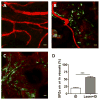Laser mimicking mosquito bites for skin delivery of malaria sporozoite vaccines
- PMID: 25725360
- PMCID: PMC4394600
- DOI: 10.1016/j.jconrel.2015.02.031
Laser mimicking mosquito bites for skin delivery of malaria sporozoite vaccines
Abstract
Immunization with radiation-attenuated sporozoites (RAS) via mosquito bites has been shown to induce sterile immunity against malaria in humans, but this route of vaccination is neither practical nor ethical. The importance of delivering RAS to the liver through circulation in eliciting immunity against this parasite has been recently verified by human studies showing that high-level protection was achieved only by intravenous (IV) administration of RAS, not by intradermal (ID) or subcutaneous (SC) vaccination. Here, we report in a murine model that ID inoculation of RAS into laser-illuminated skin confers immune protection against malarial infection almost as effectively as IV immunization. Brief illumination of the inoculation site with a low power 532 nm Nd:YAG laser enhanced the permeability of the capillary beneath the skin, owing to hemoglobin-specific absorbance of the light. The increased blood vessel permeability appeared to facilitate an association of RAS with blood vessel walls by an as-yet-unknown mechanism, ultimately promoting a 7-fold increase in RAS entering circulation and reaching the liver over ID administration. Accordingly, ID immunization of RAS at a laser-treated site stimulated much stronger sporozoite-specific antibody and CD8(+)IFN-γ(+) T cell responses than ID vaccination and provided nearly full protection against malarial infection, whereas ID immunization alone was ineffective. This novel, safe, and convenient strategy to augment efficacy of ID sporozoite-based vaccines warrants further investigation in large animals and in humans.
Keywords: Delivery; Laser; Malaria; Sporozoites; Vaccine.
Copyright © 2015 Elsevier B.V. All rights reserved.
Figures






Similar articles
-
Intradermal immunization of mice with radiation-attenuated sporozoites of Plasmodium yoelii induces effective protective immunity.Malar J. 2010 Dec 15;9:362. doi: 10.1186/1475-2875-9-362. Malar J. 2010. PMID: 21159170 Free PMC article.
-
Reduced Plasmodium berghei sporozoite liver load associates with low protective efficacy after intradermal immunization.Parasite Immunol. 2012 Dec;34(12):562-9. doi: 10.1111/pim.12000.x. Parasite Immunol. 2012. PMID: 23171040
-
The intradermal route for inoculation of sporozoites of rodent malaria parasites for immunological studies.Parasite Immunol. 2011 Feb;33(2):137-42. doi: 10.1111/j.1365-3024.2010.01263.x. Parasite Immunol. 2011. PMID: 21226727
-
Route of administration of attenuated sporozoites is instrumental in rendering immunity against Plasmodia infection.Vaccine. 2016 Jun 14;34(28):3229-34. doi: 10.1016/j.vaccine.2016.04.095. Epub 2016 May 6. Vaccine. 2016. PMID: 27160038 Review.
-
Development of whole sporozoite malaria vaccines.Expert Rev Vaccines. 2017 Jan;16(1):45-54. doi: 10.1080/14760584.2016.1203784. Epub 2016 Jul 18. Expert Rev Vaccines. 2017. PMID: 27327875 Review.
Cited by
-
Ultra-low volume intradermal administration of radiation-attenuated sporozoites with the glycolipid adjuvant 7DW8-5 completely protects mice against malaria.Sci Rep. 2024 Feb 4;14(1):2881. doi: 10.1038/s41598-024-53118-9. Sci Rep. 2024. PMID: 38311678 Free PMC article.
-
Laser adjuvant for vaccination.FASEB J. 2020 Mar;34(3):3485-3500. doi: 10.1096/fj.201902164R. Epub 2020 Jan 28. FASEB J. 2020. PMID: 31994227 Free PMC article. Review.
-
The changing shape of vaccination: improving immune responses through geometrical variations of a microdevice for immunization.Sci Rep. 2016 Jun 2;6:27217. doi: 10.1038/srep27217. Sci Rep. 2016. PMID: 27251567 Free PMC article.
-
Laser-induced capillary leakage for blood biomarker detection and vaccine delivery via the skin.J Biophotonics. 2016 Jul;9(7):676-82. doi: 10.1002/jbio.201500226. Epub 2016 Jan 18. J Biophotonics. 2016. PMID: 26776718 Free PMC article.
-
Clustering and Erratic Movement Patterns of Syringe-Injected versus Mosquito-Inoculated Malaria Sporozoites Underlie Decreased Infectivity.mSphere. 2021 Apr 7;6(2):e00218-21. doi: 10.1128/mSphere.00218-21. mSphere. 2021. PMID: 33827910 Free PMC article.
References
-
- World Health Organization. World Malaria Report 2013. 2013
-
- Kester KE, Cummings JF, Ofori-Anyinam O, et al. Randomized, double-blind, phase 2a trial of falciparum malaria vaccines RTS, S/AS01B and RTS, S/AS02A in malaria-naive adults: safety, efficacy, and immunologic associates of protection. J Infect Dis. 2009;200(3):337–46. - PubMed
-
- Seder RA, Chang LJ, Enama ME, et al. Protection against malaria by intravenous immunization with a nonreplicating sporozoite vaccine. Science. 2013;341(6152):1359–65. - PubMed
-
- Hoffman SL, Goh LM, Luke TC, et al. Protection of humans against malaria by immunization with radiation-attenuated Plasmodium falciparum sporozoites. J Infect Dis. 2002;185(8):1155–64. - PubMed
Publication types
MeSH terms
Substances
Grants and funding
LinkOut - more resources
Full Text Sources
Other Literature Sources
Medical
Research Materials

